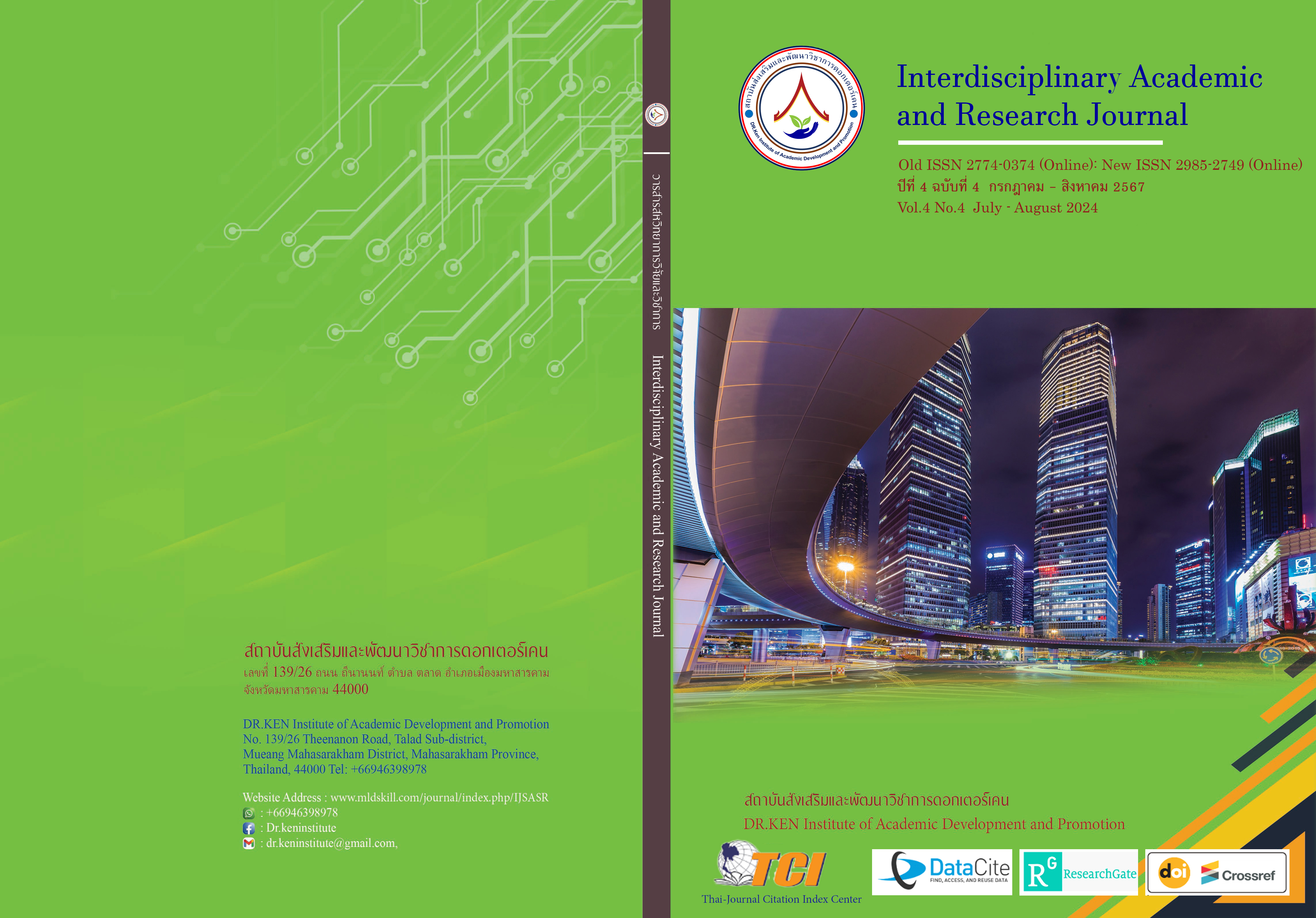Meaning of the Word 'น้ำ' (N̂ả) in Thai
DOI:
https://doi.org/10.60027/iarj.2024.279266Keywords:
Water; , Structure; , Meaning; , Metaphor; , WordAbstract
Background and Aims: Compared to other societies, water is the most obvious symbol in Thai society. Water is present in a wide range of artistic mediums, including painting, sculpture, architecture, dance, rituals, and even urban planning. The Thai people's way of life and means of subsistence are influenced by water. Because of this, the word "water" has acquired significance in Thai culture and language. Thus, The research article on the meaning of the Word 'น้ำ' in the Thai Language aims to study the characteristics of appearance and meaning of the word 'น้ำ' in the Thai language.
Methodology: The researcher collected and compiled data related to the theory and research on semantics, gathering information on the word "น้ำ" (water) from the National Thai Language Corpus, totaling 500 instances. Subsequently, the data was analyzed to explore the meaning of the word "น้ำ" by examining its co-occurrences with various types of words, analyzing users' mental representations of its form and characteristics, as well as the semantic extensions of the word "น้ำ". Finally, the research findings were summarized using a phenomenological analysis method.
Results: From the study, it is found that the extension of the meaning of the word 'water' as the base word in compounds can be achieved in 4 ways: 1) by extending with a noun, 2) by extending with a verb, 3) by extending with a compound word, and 4) by extending with an equative compound word. As for the extension of the meaning of 'water' functioning as a phrase, it uses the metaphorical extension. The metaphor 'water' signifies valuable property and wealth. The conceptual system of water is that water is a valuable asset."
Conclusion: The semantic extension of the word 'น้ำ' (water) occurs through four methods, with its metaphorical extensions employing the metaphorical method. The conceptual system of water is that it is a valuable asset.
References
กัญจณ์ปภัสส์ สุวรรณวิหค. (2558) .“น้ำ” ในวรรณกรรมนิทานสมัยรัตนโกสินทร์ตอนต้น (รัชกาลที่ 1-3). วิทยานิพนธ์ปริญญามหาบัณฑิต : มหาวิทยาลัยธรรมศาสตร์.
กำชัย ทองหล่อ. (2556). หลักภาษาไทย. พิมพ์ครั้งที่ 50. กรุงเทพฯ : รวมสาส์น.
กิตติมา พุ่มซ้อน. (2554). การศึกษาอุปลักษณ์ “น้ำ” ในสำนวนไทย. วิทยานิพนธ์ปริญญามหาบัณฑิต : มหาวิทยาลัยเกษตรศาสตร์.
ชัยวัฒน์ สีแก้ว (2537). คำไทย 7 ชนิด ฉบับนักเรียน นักศึกษา.กรุงเทพฯ: หอสมุดกลาง
นันทนา วงษ์ไทย. (2562). อรรถศาสตร์ปริชานเบื้องต้น. กรุงเทพฯ : เวิร์ค ออล พริ๊นท์.
พิชญาณี เชิงคีรี ไชยยะ และคณะ. (2560). เอกสารประกอบการเรียนการสอนรายวิชา การใช้ภาษาไทยอย่างมีวิจารณญาณเพื่อการสื่อสาร. ปทุมธานี: มหาวิทยาลัยราชภัฏวไลยอลงกรณ์ ในพระบรมราชูปถัมภ์.
ภาณุวัฒน์ สกุลสืบ. (2565). "น้ำ" ในระบอบประเพณีและพิธีกรรมของไทย. วิทยานิพนธ์ปริญญาดุษฎีบัณฑิต: มหาวิทยาลัยนเรศวร.
สรัญญา วรานฤชิต. (2557). การวิเคราะห์อุปลักษณ์เชิงวิพากษ์ในการรายงานสดข่าวอุทกภัยทางโทรทัศน์ไทย.วิทยานิพนธ์ปริญญามหาบัณฑิต : มหาวิทยาลัยธรรมศาสตร์.
สุนันท์ อัญชลีนุกูล. (2546). ระบบคำภาษาไทย. กรุงเทพฯ : จุฬาลงกรณ์มหาวิทยาลัย.
สุเมธ ชุมสาย ณ อยุธยา. (2529). น้ำบ่อเกิดแห่งวัฒนธรรมไทย. กรุงเทพฯ : ไทยวัฒนาพาณิช.
สุริยา รัตนกุล. (2555). อรรถศาสตร์เบื้องต้น. นครปฐม : สำนักพิมพ์มหาวิทยาลัยมหิดล.
อลิษา อินจันทร์. (2557). คำประสมเท่าเทียมในภาษาไทย. วิทยานิพนธ์ปริญญา : จุฬาลงกรณ์มหาวิทยาลัย.
Muzika. (2565). Including 10 important rivers, the beginnings of world civilization. Retrieved on 7 July 2024 from: https://travel.trueid.net/detail/nvZRPMalknXv
Saeed, A. (2009). Legal Protection Methods for E-commerce Transactions. Beirut: AlHalabi Legal Publications.
Downloads
Published
How to Cite
Issue
Section
License
Copyright (c) 2024 Interdisciplinary Academic and Research Journal

This work is licensed under a Creative Commons Attribution-NonCommercial-NoDerivatives 4.0 International License.
Copyright on any article in the Interdisciplinary Academic and Research Journal is retained by the author(s) under the under the Creative Commons Attribution-NonCommercial-NoDerivatives 4.0 International License. Permission to use text, content, images, etc. of publication. Any user to read, download, copy, distribute, print, search, or link to the full texts of articles, crawl them for indexing, pass them as data to software, or use them for any other lawful purpose. But do not use it for commercial use or with the intent to benefit any business.
















.png)


